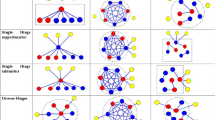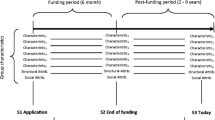Abstract
The role of geographical proximity in fostering connections and knowledge flows between innovative actors ranks among the most controversial themes in the research of innovation systems, regional networks and new economic geography. While there is ample empirical evidence on the constituent force of co-location for the formation of research alliances, little attention has been paid to the actual consequences of geographical concentration of alliance partners for the subsequent performance of these linkages. In this paper, we address this underexplored issue and aim to complement the rare examples of studies on the relevance of geographical proximity for research outputs. We utilize original and unique survey data from collaborative R&D projects that were funded within the “Leading-Edge Cluster Competition” (LECC)—the main national cluster funding program in Germany in recent years. We find that the perception of the necessity of geographical proximity for project success is rather heterogeneous among the respondents of the funded projects. Moreover, the relationship between geographical distance and project success is by no means univocal and is mediated by various technological, organizational and institutional aspects. Our findings strongly support the assumption that the nature of knowledge involved determines the degree to which collaborators are reliant on being closely located to each other. The relevance of geographical proximity increases in exploration contexts when knowledge is novel and the innovation endeavor is more radical, while this effect is less pronounced for projects with a stronger focus on basic research. Moreover, geographical proximity and project satisfaction foster cross-fertilization effects of LECC projects.



Similar content being viewed by others
Notes
Cluster partners do not necessarily have to be located in the cluster region.
Since the third wave was selected in 2012 and the distribution of funds for the single projects effectively started in 2013, it was too early to collect meaningful data by means of surveys with these beneficiaries.
n − 1 because the cumulative probabilities are computed and this would equal 1 for the n-th category.
For the further analysis, we always consider the predicted values from the reduced model either without actor and cluster dummies (step 1) or without cluster dummies (step 2).
Some of the projects were still running while the survey was conducted.
References
Agrawal, A., Kapurc, D., & McHaled, J. (2008). How do spatial and social proximity influence knowledge flows? Evidence from patent data. Journal of Urban Economics,64(2), 258–269.
Ahuja, G. (2000). Collaboration networks, structural holes and innovation: A longitudinal study. Administrative Science Quarterly,45, 425–455.
Audretsch, D. B., & Feldman, M. P. (1996). R&D spillovers and the geography of innovation and production. American Economic Review,86(3), 630–640.
Hazir, S., & Autant-Bernard, C. (2011). Conceptualizing the role of geographical proximity in project based R&D networks: A literature survey. In ERSA Conference Papers ersa11p1616, European Regional Science Association.
Balland, P. A., de Vaan, M., & Boschma, R. (2013). The dynamics of interfirm networks along the industry life cycle: The case of the global video game industry, 1987–2007. Journal of Economic Geography,13(5), 741–765.
Baptista, R., & Swann, P. (1998). Do firms in clusters innovate more? Research Policy,27, 525–540.
Bathelt, H., Malmberg, A., & Maskell, P. (2004). Clusters and knowledge: Local buzz, global pipelines and the process of knowledge creation. Progress in Human Geography,28, 31–56.
Boschma, R. A. (2005). Proximity and innovation: A critical assessment. Regional Studies,39(1), 61–74.
Braczyk, H.-J., Cooke, P., & Heidenreich, M. (1998). Regional innovation systems: The role of governances in a globalized world. London: UCL Press.
Breschi, S., & Lissoni, F. (2001). Knowledge spillovers and local innovation systems: A critical survey. Industrial and Corporate Change,10(4), 975–1005.
Breschi, S., & Lissoni, F. (2003). Mobility and social networks: Localised knowledge spillovers revisited. In Proceedings of the Workshop on Empirical Economics of Innovation and Patenting. Zentrum für Europäische Wirtschaftsforschung (ZEW), Mannheim, 14–15 March.
Breschi, S., & Lissoni, F. (2009). Mobility of skilled workers and co-invention networks: An anatomy of localized knowledge flows. Journal of Economic Geography,9(4), 439–468.
Broekel, T., & Boschma, R. (2012). Knowledge networks in the Dutch aviation industry: The proximity paradox. Journal of Economic Geography,12(2), 409–433.
Brown, M. G., & Svenson, R. A. (1988). Measuring R&D productivity. Research Technology Management,31, 11–15.
Cantner, U., & Graf, H. (2011). Innovation Networks: Formation, performance and dynamics. In C. Antonelli (Ed.), Handbook on the economic complexity of technological change, Chapter 15. Cheltenham: Edward Elgar.
Cantner, U., & Meder, A. (2007). Technological proximity and the choice of cooperation partners. Journal of Economic Interaction and Coordination,2(1), 45–65.
Cassi, L., Morrison, A., & Rabellotti, R. (2014). Proximity and scientific collaboration: Evidence from the global wine industry. In Papers in Evolutionary Economic Geography (PEEG) 1405. Utrecht University.
Cassi, L., & Plunket, A. (2012). Research collaboration in co-inventor networks: Combining closure, bridging and proximities. In MPRA Paper 39481. University Library of Munich, Germany.
Cassi, L., & Plunket, A. (2014). Proximity, network formation and inventive performance: In search of the proximity paradox. The Annals of Regional Science,53(2), 395–422.
Cohen, W., & Levinthal, D. (1990). Absorptive capacity: A new perspective on learning and innovation. Administrative Science Quarterly,35(1), 128–152.
Cooke, P., Uranga, M. G., & Etxebarria, G. (1997). Regional innovation systems: Institutional and organisational dimensions. Research Policy,26, 475–491.
Cowan, R., David, P., & Foray, D. (2000). The explicit economics of knowledge codification and tacitness. Industrial and Corporate Change,9(2), 211–254.
Crescenzi, R. (2014). The evolving dialogue between innovation and economic geography. From physical distance to non-spatial proximities and ‘integrated’ frameworks. In Papers in Evolutionary Economic Geography (PEEG) 1408. Utrecht University.
D’Este, P., & Iammarino, S. (2010). The spatial profile of university-business research partnerships. Papers in Regional Science,89(2), 335–350.
Eickelpasch, E., & Fritsch, M. (2005). Contests for cooperation: A new approach in German innovation policy. In Discussion Papers of DIW Berlin 478, DIW Berlin. German Institute for Economic Research.
Fitjar, R. D., Huber, F., & Rodríguez-Pose, A. (2016). Not too close, not too far: Testing the Goldilocks principle of ‘optimal’ distance in innovation networks. In: Papers in Evolutionary Economic Geography, #1609.
Frenken, K., van Oort, F. G., & Verburg, T. (2007). Related variety, unrelated variety and regional economic growth. Regional Studies,41(5), 685–697.
Galliano, D., Magrini, M. B., & Triboulet, P. (2015). Marshall’s versus Jacobs’ externalities in firm innovation performance: The case of French industry. Regional Studies,49(11), 1840–1858.
Garcia, R., Araujo, V. C., Mascarini, S., Santos, E. G., & Costa, A. (2013). Geographical proximity and the role of the quality of academic research to the university-industry linkages. In Presented at the Regional Studies Association European Conference 2013 “Shape and be Shaped: The Future Dynamics of Regional Development”, RSA 2013, Tampere, 5th–8th May 2013.
Giuliani, E. (2007). The selective nature of knowledge networks in clusters: Evidence from the wine industry. Journal of Economic Geography,7(2), 139–168.
Gulati, R. (1995). Does familiarity breed trust? The implications of repeated ties for contractual choice in alliances. Academy of Management Journal,38, 85–112.
Gulati, R., & Gargiulo, M. (1999). Where do interorganizational networks come from? American Journal of Sociology,104, 1439–1493.
Hamel, G. (1991). Competition for competence and interpartner learning within international strategic alliances. Strategic Management Journal,12, 83–103. doi:10.1002/smj.4250120908.
Jaffe, A. B., Trajtenberg, M., & Henderson, R. (1993). Geographic localisation of knowledge spillovers as evidenced by patent citations. Quarterly Journal of Economics,10, 577–598.
Katz, J. S. (1994). Geographical proximity and scientific collaboration. Scientometrics,31(1), 31–43.
Koschatzky, K. (2000). The regionalisation of innovation policy in Germany. Theoretical Foundations and Recent Experience, Arbeitspapiere Unternehmen und Region, R1/2000. Karlsruhe: Fraunhofer-Institut für System- und Innovationsforschung.
Lhuillery, S., & Pfister, E. (2009). R&D cooperation and failures in innovation projects: Empirical evidence from French CIS data. Research Policy,38(1), 45–57.
Mansfield, E., & Lee, J. (1996). The modern university: Contributor to industrial innovation and receipt of industrial R&D support. Research Policy,25, 1047–1058.
March, J. G. (1991). Exploration and exploitation in organizational learning. Organization Science,2, 71–87.
Marshall, A. (1890). Principles of economics: An introductory volume. London: MacMillan.
Mora-Valentin, E., Montoro-Sanchez, A., & Guerras-Martin, L. A. (2004). Determining factors in the success of R&D cooperative agreements between firms and research organizations. Research Policy,33, 17–40.
Mowery, D. C., Oxley, J. E., & Silverman, B. S. (1998). Technological overlap and interfirm cooperation: Implications for the resource-based view of the firm. Research Policy,27, 507–523.
Nooteboom, B., Van Haverbeke, W., Duysters, G., Gilsing, V., & van den Oord, A. (2007). Optimal cognitive distance and absorptive capacity. Research Policy,36, 1016–1034.
Oerlemans, L., & Meeus, M. (2005). Do organizational and spatial proximity impact on firm performance? Regional Studies,39(1), 89–104.
Polanyi, M. (1966). The tacit dimension. New York: Doubleday Anchor.
Porter, M. (1990). The competitive advantage of nations. New York: Free Press.
Porter, M. (1998). Clusters and the new economics of competition. Harvard Business Review,76(6), 77–90.
Rothgang, M., Cantner, U., Dehio, J., Engel, D., Fertig, M., Graf, H., et al. (2014). Accompanying evaluation of the funding instrument “Spitzencluster-Wettbewerb” (Leading-Edge Cluster Competition) of the federal ministry of education and research: Research project for the federal ministry of education and research. Final report-Summary (No. 83) 11/2008–4/2014. RWI Materialien.
Singh, J. (2005). Collaborative networks as determinants of knowledge diffusion patterns. Management Science,51(5), 756–770.
Staber, U. (2001). Spatial proximity and firm survival in a declining industrial district: The case of knitwear firms in Baden-Württemberg. Regional Studies,35, 329–341.
Ter Wal, A., & Boschma, R. (2009). Applying social network analysis in economic geography: Framing some key analytical issues. Annals of Regional Science,43, 739–756.
Torre, A., & Wallet, F. (2014). Introduction. The role of proximity relations in regional and territorial development processes. In A. Torre & F. Wallet (Eds.), Regional development and proximity relations, new horizons in regional science (pp. 375–419). London: Edward Elgar.
Van Oort, F., de Geus, S., & Dogaru, T. (2015). Related variety and regional economic growth in a cross-section of European urban regions. European Planning Studies,23(6), 1110–1127.
Wooldridge, J. M. (2002). Econometric analysis of cross section and panel data. Massachusetts: The MIT Press Cambridge.
Acknowledgements
The study was financially supported by the Federal Ministry of Education and Research (BMBF) for the research project “Begleitende Evaluierung des Spitzencluster-Wettbewerbs” Susanne Hinzmann thankfully acknowledges the German Research Foundation (DFG) for providing a scholarship within the DFG-GRK 1411 “The Economics of Innovative Change”. We wish to thank two anonymous referees, members the research group DFG-GRK 1411, as well as participants at the 7th Summer Conference in Regional Science in Marburg and the Workshop on “Clusterforschung und Evaluierung von Clusterpolitiken” for helpful comments and suggestions. All remaining errors are our own.
Author information
Authors and Affiliations
Corresponding author
Appendix
Rights and permissions
About this article
Cite this article
Hinzmann, S., Cantner, U. & Graf, H. The role of geographical proximity for project performance: evidence from the German Leading-Edge Cluster Competition. J Technol Transf 44, 1744–1783 (2019). https://doi.org/10.1007/s10961-017-9600-1
Published:
Issue Date:
DOI: https://doi.org/10.1007/s10961-017-9600-1




